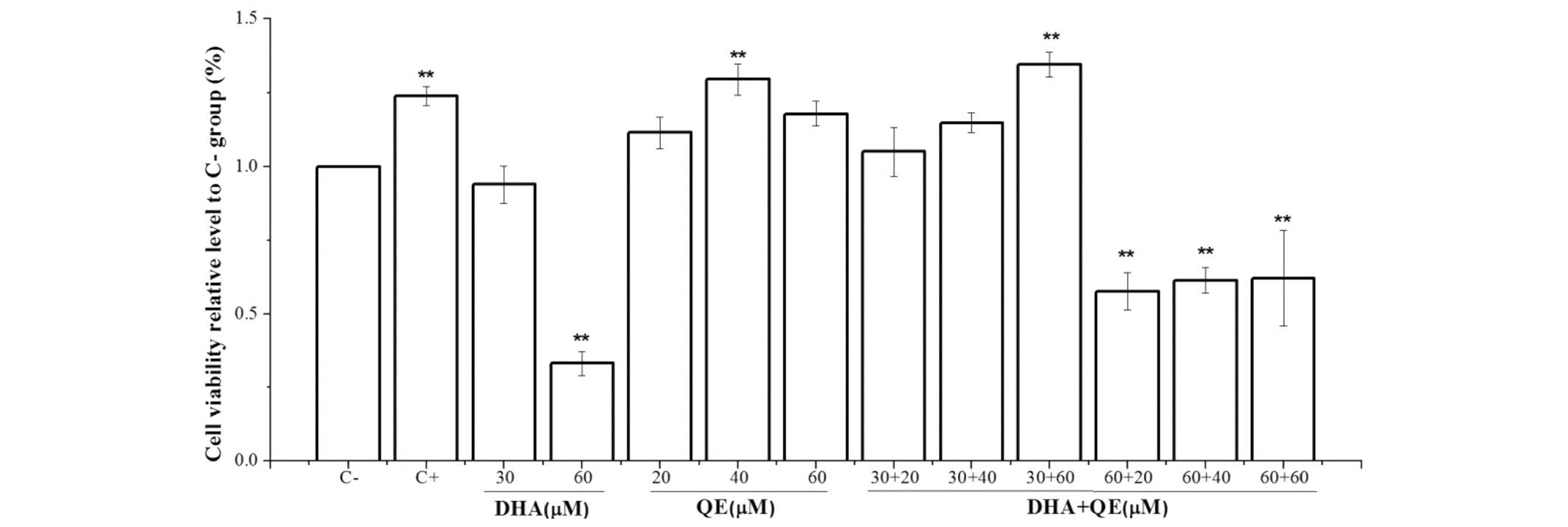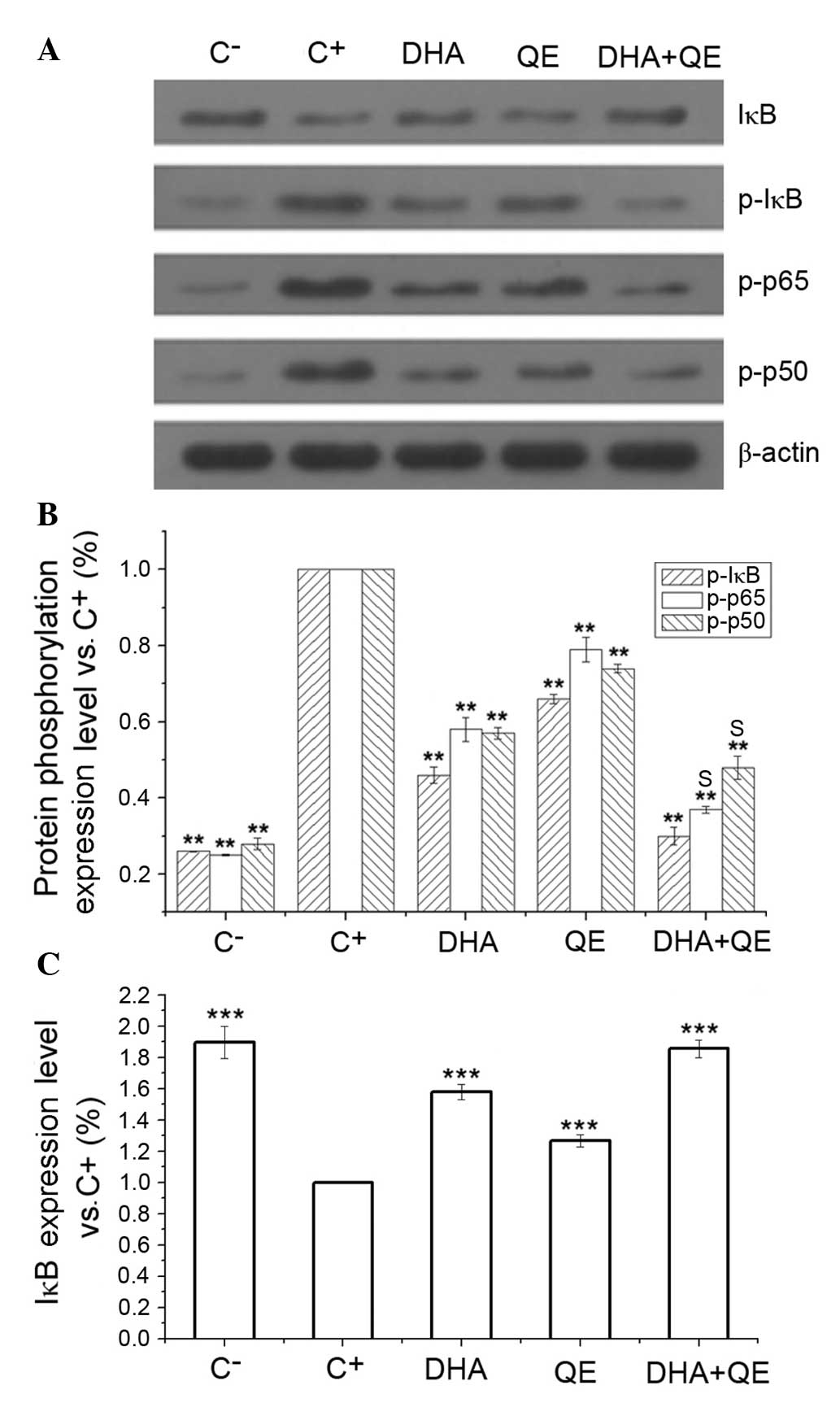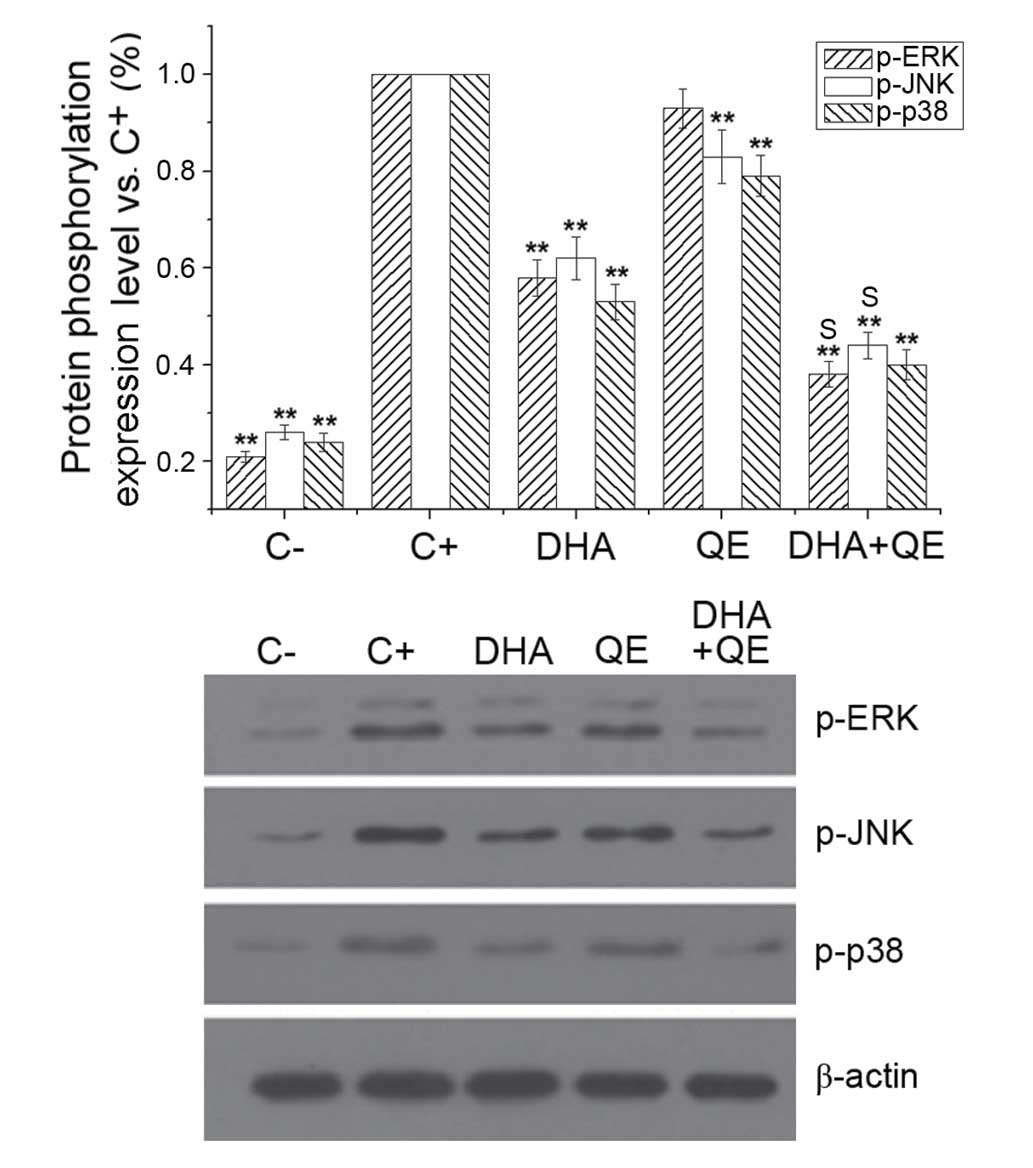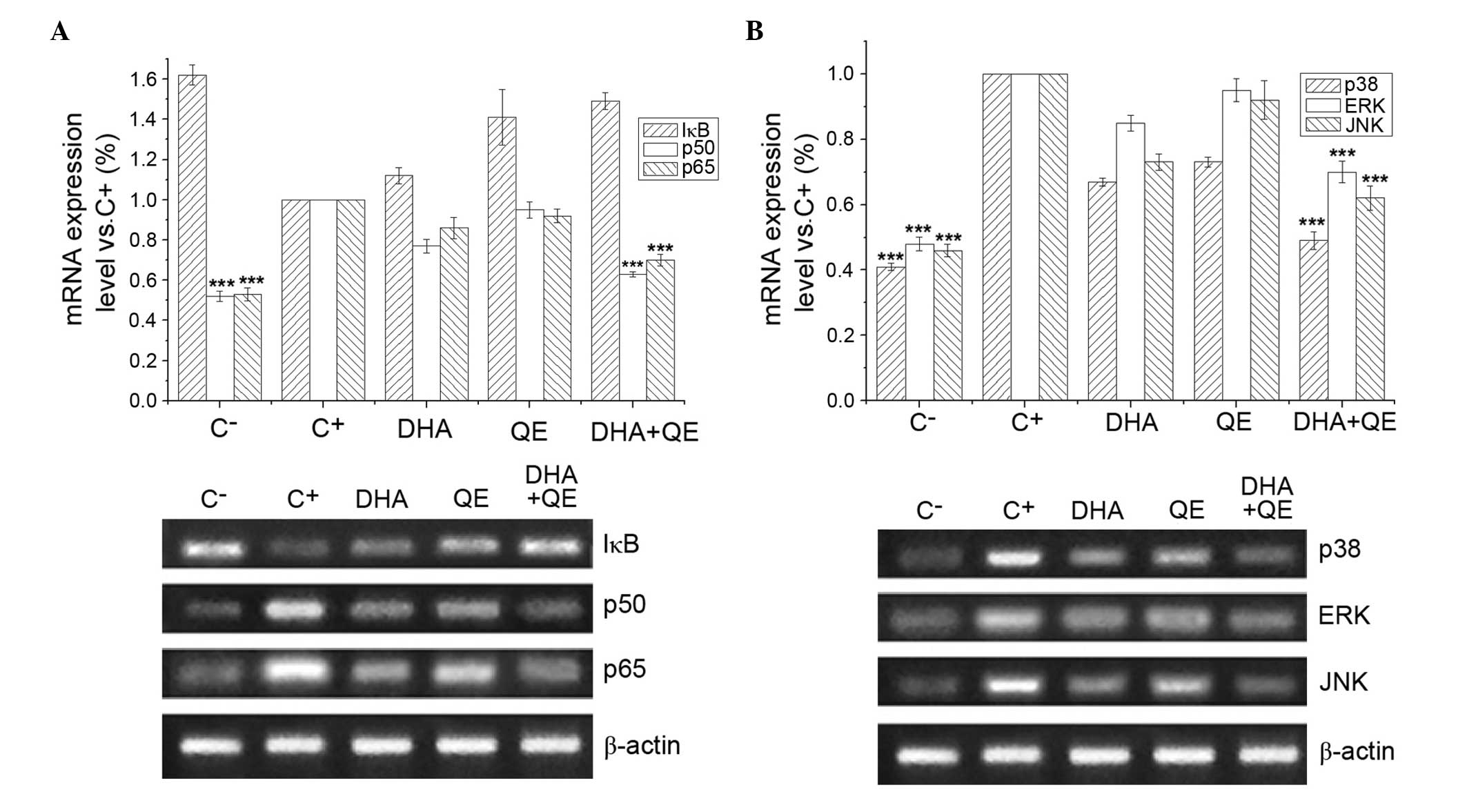|
1
|
Lorente-Cebrián S, Costa AG,
Navas-Carretero S, Zabala M, Martínez JA and Moreno-Aliaga MJ: Role
of omega-3 fatty acids in obesity, metabolic syndrome, and
cardiovascular diseases: A review of the evidence. J Physiol
Biochem. 69:633–651. 2013. View Article : Google Scholar : PubMed/NCBI
|
|
2
|
Yang D, Lin J, Chen Y, Liu S, Lu F, Chang
T, Wang M, Lin H and Chang Y: Suppressive effect of carotenoid
extract of Dunaliella salina alga on production of LPS-stimulated
pro-inflammatory mediators in RAW264.7 cells via NF-kB and JNK
inactivation. J Funct Foods. 5:607–615. 2013. View Article : Google Scholar
|
|
3
|
Pan MH, Lai CS and Ho CT:
Anti-inflammatory activity of natural dietary flavonoids. Food
Funct. 1:15–31. 2010. View Article : Google Scholar : PubMed/NCBI
|
|
4
|
Hsu CL, Fang SC and Yen GC:
Anti-inflammatory effects of phenolic compounds isolated from the
flowers of Nymphaea mexicana Zucc. Food Funct. 4:1216–1222. 2013.
View Article : Google Scholar : PubMed/NCBI
|
|
5
|
Huang N, Hauck C, Yum MY, Rizshsky L,
Widrlechner MP, McCoy JA, Murphy PA, Dixon PM, Nikolau BJ and Birt
DF: Rosmarinic acid in Prunella vulgaris ethanol extract inhibits
lipopolysaccharide-induced prostaglandin E2 and nitric oxide in RAW
264.7 mouse macrophages. J Agric Food Chem. 57:10579–10589. 2009.
View Article : Google Scholar : PubMed/NCBI
|
|
6
|
Lai C, Lai Y, Kuo D, Wu C, Ho C and Pan M:
Magnolol potently suppressed lipopolysaccharide-induced iNOS and
COX-2 expression via downregulating MAPK and NF-κB signaling
pathways. J Funct. 3:198–206. 2011.
|
|
7
|
Chiu FL and Lin JK: Tomatidine inhibits
iNOS and COX-2 through suppression of NF-κB and JNK pathways in
LPS-stimulated mouse macrophages. FEBS Lett. 582:2407–2412. 2008.
View Article : Google Scholar : PubMed/NCBI
|
|
8
|
Kim KJ, Yoon KY and Lee BY: Low molecular
weight fucoidan from the sporophyll of Undaria pinnatifida
suppresses inflammation by promoting the inhibition of
mitogen-activated protein kinases and oxidative stress in RAW264.7
cells. Fitoterapia. 83:1628–1635. 2012. View Article : Google Scholar : PubMed/NCBI
|
|
9
|
Avior Y, Bomze D, Ramon O and Nahmias Y:
Flavonoids as dietary regulators of nuclear receptor activity. Food
Funct. 4:831–844. 2013. View Article : Google Scholar : PubMed/NCBI
|
|
10
|
Ahn J, Lee H, Kim S, Park J and Ha T: The
anti-obesity effect of quercetin is mediated by the AMPK and MAPK
signaling pathways. Biochem Biophys Res Commun. 373:545–549. 2008.
View Article : Google Scholar : PubMed/NCBI
|
|
11
|
Lin HY, Juan SH, Shen SC, Hsu FL and Chen
YC: Inhibition of lipopolysaccharide-induced nitric oxide
production by flavonoids in RAW264.7 macrophages involves heme
oxygenase-1. Biochem Pharmacol. 66:1821–1832. 2003. View Article : Google Scholar : PubMed/NCBI
|
|
12
|
Chow JM, Shen SC, Huan SK, Lin HY and Chen
YC: Quercetin, but not rutin and quercitrin, prevention of
H2O2-induced apoptosis via anti-oxidant
activity and heme oxygenase 1 gene expression in macrophages.
Biochem Pharmacol. 69:1839–1851. 2005. View Article : Google Scholar : PubMed/NCBI
|
|
13
|
Strobel P, Allard C, Perez-Acle T,
Calderon R, Aldunate R and Leighton F: Myricetin, quercetin and
catechin-gallate inhibit glucose uptake in isolated rat adipocytes.
Biochem J. 386:471–478. 2005. View Article : Google Scholar :
|
|
14
|
Das N, Sikder K, Bhattacharjee S, Majumdar
SB, Ghosh S, Majumdar S and Dey S: Quercetin alleviates
inflammation after short-term treatment in high-fat-fed mice. Food
Funct. 4:889–898. 2013. View Article : Google Scholar : PubMed/NCBI
|
|
15
|
Firdous AB, Sharmila G, Balakrishnan S,
RajaSingh P, Suganya S, Srinivasan N and Arunakaran J: Quercetin, a
natural dietary flavonoid, acts as a chemopreventive agent against
prostate cancer in an in vivo model by inhibiting the EGFR
signaling pathway. Food Funct. 5:2632–2645. 2014. View Article : Google Scholar : PubMed/NCBI
|
|
16
|
Pallarès V, Calay D, Cedó L, Castell-Auví
A, Raes M, Pinent M, Ardévol A, Arola L and Blay M: Enhanced
anti-inflammatory effect of resveratrol and EPA in treated
endotoxin-activated RAW 264.7 macrophages. Br J Nutr.
108:1562–1573. 2012. View Article : Google Scholar : PubMed/NCBI
|
|
17
|
Venegas-Calerón M, Sayanova O and Napier
JA: An alternative to fish oils: Metabolic engineering of oil-seed
crops to produce omega-3 long chain polyunsaturated fatty acids.
Prog Lipid Res. 49:108–119. 2010. View Article : Google Scholar
|
|
18
|
Mullen A, Loscher CE and Roche H:
Anti-inflammatory effects of EPA and DHA are dependent upon time
and dose-response elements associated with LPS stimulation in
THP-1-derived macrophages. J Nutr Biochem. 21:444–450. 2010.
View Article : Google Scholar
|
|
19
|
Pallarès V, Calay D, Cedó L, Castell-Auví
A, Raes M, Pinent M, Ardévol A, Arola L and Blay M: Additive,
antagonistic, and synergistic effects of procyanidins and
polyunsaturated fatty acids over inflammation in RAW 264.7
macrophages activated by lipopolysaccharide. Nutrition. 28:447–457.
2012. View Article : Google Scholar
|
|
20
|
Choi EY, Jin JY, Choi JI, Choi IS and Kim
SJ: DHA suppresses Prevotella intermedia lipopolysaccharide-induced
production of proinflammatory mediators in murine macrophages. Br J
Nutr. 111:1221–1230. 2014. View Article : Google Scholar
|
|
21
|
Manjeet KR and Ghosh B: Quercetin inhibits
LPS-induced nitric oxide and tumor necrosis factor-α production in
murine macrophages. Int J Immunopharmacol. 21:435–443. 1999.
View Article : Google Scholar
|
|
22
|
Boots AW, Haenen GR and Bast A: Health
effects of quercetin: From antioxidant to nutraceutical. Eur J
Pharmacol. 585:325–337. 2008. View Article : Google Scholar : PubMed/NCBI
|
|
23
|
Saw CL, Huang Y and Kong AN: Synergistic
anti-inflammatory effects of low doses of curcumin in combination
with polyunsaturated fatty acids: Docosahexaenoic acid or
eicosapentaenoic acid. Biochem Pharmacol. 79:421–430. 2010.
View Article : Google Scholar
|
|
24
|
Rusca A, Di Stefano AF, Doig MV, Scarsi C
and Perucca E: Relative bioavailability and pharmacokinetics of two
oral formulations of docosahexaenoic acid/eicosapentaenoic acid
after multiple-dose administration in healthy volunteers. Eur J
Clin Pharmacol. 65:503–510. 2009. View Article : Google Scholar : PubMed/NCBI
|
|
25
|
Leiherer A, Mündlein A and Drexel H:
Phytochemicals and their impact on adipose tissue inflammation and
diabetes. Vascul Pharmacol. 58:3–20. 2013. View Article : Google Scholar
|
|
26
|
Sun M, Nie S, Pan X, Zhang R, Fan Z and
Wang S: Quercetin-nanostructured lipid carriers: Characteristics
and anti-breast cancer activities in vitro. Colloids Surf
Biointerfaces. 113:15–24. 2014. View Article : Google Scholar
|
|
27
|
Russo M, Spagnuolo C, Tedesco I, Bilotto S
and Russo GL: The flavonoid quercetin in disease prevention and
therapy: Facts and fancies. Biochem Pharmacol. 83:6–15. 2012.
View Article : Google Scholar
|
|
28
|
Endale M, Park SC, Kim S, Kim SH, Yang Y,
Cho JY and Rhee MH: Quercetin disrupts tyrosine-phosphorylated
phosphatidylinositol 3-kinase and myeloid differentiation factor-88
association, and inhibits MAPK/AP-1 and IKK/NF-κB-induced
inflammatory mediators production in RAW 264.7 cells.
Immunobiology. 218:1452–1467. 2013. View Article : Google Scholar : PubMed/NCBI
|
|
29
|
Gomes A, Fernandes E, Lima JL, Mira L and
Corvo ML: Molecular mechanisms of anti-inflammatory activity
mediated by flavonoids. Curr Med Chem. 15:1586–1605. 2008.
View Article : Google Scholar : PubMed/NCBI
|
|
30
|
Kalupahana NS, Claycombe KJ and
Moustaid-Moussa N: (n-3) Fatty acids alleviate adipose tissue
inflammation and insulin resistance: Mechanistic insights. Adv
Nutr. 2:304–316. 2011. View Article : Google Scholar :
|
|
31
|
Oh DY, Talukdar S, Bae EJ, Imamura T,
Morinaga H, Fan W, Li P, Lu WJ, Watkins SM and Olefsky JM: GPR120
is an omega-3 fatty acid receptor mediating potent
anti-inflammatory and insulin-sensitizing effects. Cell.
142:687–698. 2010. View Article : Google Scholar : PubMed/NCBI
|
|
32
|
Wall R, Ross RP, Fitzgerald GF and Stanton
C: Fatty acids from fish: The anti-inflammatory potential of
long-chain omega-3 fatty acids. Nutr Rev. 68:280–289. 2010.
View Article : Google Scholar : PubMed/NCBI
|
|
33
|
Peet GW and Li J: IκB Kinases α and β show
a random sequential kinetic mechanism and are inhibited by
staurosporine and quercetin. J Biol Chem. 274:32655–32661. 1999.
View Article : Google Scholar : PubMed/NCBI
|
|
34
|
Feng D, Ling WH and Duan RD: Lycopene
suppresses LPS-induced NO and IL-6 production by inhibiting the
activation of ERK, p38MAPK, and NF-kappaB in macrophages. Inflamm
Res. 59:115–121. 2010. View Article : Google Scholar
|
|
35
|
Blüthgen N and Legewie S: Systems analysis
of MAPK signal transduction. Essays Biochem. 45:95–107. 2008.
View Article : Google Scholar : PubMed/NCBI
|
|
36
|
Turjanski AG, Vaqué JP and Gutkind JS: MAP
kinases and the control of nuclear events. Oncogene. 26:3240–3253.
2007. View Article : Google Scholar : PubMed/NCBI
|
|
37
|
Lo CJ, Chiu KC, Fu M, Chu A and Helton S:
Fish oil modulates macrophage P44/P42 mitogen-activated protein
kinase activity induced by lipopolysaccharide. JPEN J Parenter
Enteral Nutr. 24:159–163. 2000. View Article : Google Scholar : PubMed/NCBI
|
|
38
|
Moon Y and Pestka JJ:
Deoxynivalenol-induced mitogen-activated protein kinase
phosphorylation and IL-6 expression in mice suppressed by fish oil.
J Nutr Biochem. 14:717–726. 2003. View Article : Google Scholar : PubMed/NCBI
|
|
39
|
Cho SY, Park SJ, Kwon MJ, Jeong TS, Bok
SH, Choi WY, Jeong WI, Ryu SY, Do SH, Lee CS, et al: Quercetin
suppresses proinflammatory cytokines production through MAP kinases
and NF-kappaB pathway in lipopolysaccharide-stimulated macrophage.
Mol Cell Biochem. 243:153–160. 2003. View Article : Google Scholar : PubMed/NCBI
|
|
40
|
Hohmann HP, Remy R, Scheidereit C and van
Loon AP: Maintenance of NF-kappa B activity is dependent on protein
synthesis and the continuous presence of external stimuli. Mol Cell
Biol. 11:259–266. 1991. View Article : Google Scholar : PubMed/NCBI
|















